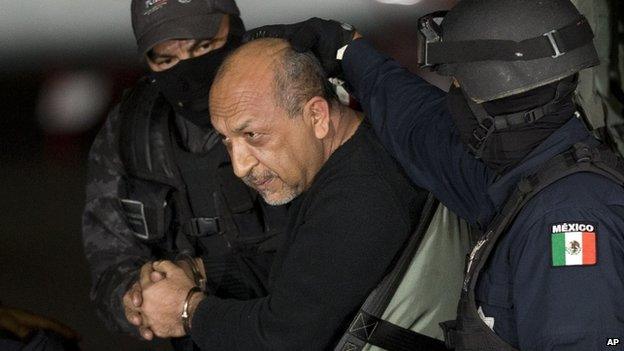Mexico arrests Zetas cartel leader Omar Trevino Morales
- Published

Omar Trevino Morales, known as Z-42, is also wanted in the United States
Omar Trevino Morales, leader of the notorious Zetas drugs cartel in Mexico, has been captured by security forces.
He was arrested in the early hours of Wednesday in the city of Monterrey in the northern state of Nuevo Leon, police said.
He is believed to have run the Zetas cartel since the capture of his brother, Miguel Angel, in 2013.
The arrest comes days after Mexican police captured another suspected drug lord, Servando "La Tuta" Gomez.
Servando Gomez was the leader of the Knights Templar cartel in Michoacan state.
Omar Trevino Morales, known as Z-42 and believed to be 40 or 41 years old, is wanted in the US, external and Mexico on charges of drug trafficking, kidnap and murder.
The Mexican government had a 30m peso (£1.3m; $2m) reward for his capture while the US offered a $5m (£3.2m) reward.
'Extremely violent profile'
Mexican media, citing officials, said he had been seized in the Monterrey suburb of San Pedro Garza Garcia in a joint operation by the army and the federal police.
He was arrested in a luxury home without a shot being fired, local media said.

Omar Trevino Morales was arrested in a house in a suburb of Monterrey

Servando Gomez was Mexico's most wanted fugitive until his arrest last Friday
Neighbours told El Universal newspaper the house had been bought about six months ago by a family "which kept themselves to themselves and did not mingle with other neighbours".
He has been transferred under heavy security to Mexico City and paraded before television cameras.
National Security Commission Director Monte Alejandro Rubido Garcia said intelligence gatherings since the capture of Omar Trevino's brother led to his arrest.
"For the past few years, he's been one of the country's most-wanted delinquents, with an extremely violent profile," said Mr Rubido.

Analysis by Katy Watson, BBC News, Mexico City
The BBC's Katy Watson was taken inside one drug lord's cave hideout
The capture of not just one - but two - drugs kingpins in less than a week is a coup for the Mexican government. It has come in for criticism in recent months for failing to quell the violence.
The government will, of course, be proud of its achievements and the cartel will be weakened by this latest arrest, but this is not the end of "Los Zetas".
With operations across several states and a reputation for being one of the most violent drugs cartels in the country, experts say that the way it is structured means it will bounce back and will still represent a formidable challenge to security in Mexico.

Mike Vigil, a retired chief of international operations for the US Drug Enforcement Administration, told the AFP news agency that the arrest meant that the last of the "solid leaders within the Zetas is gone".
"With this I think that the Zetas are going to have a very large void in terms of leadership. The big problem here, though, is that if the Zetas splinter into other organisations, then that can lead to violence in terms of the internal competition."
Gruesome tactics
The Zetas were created in the 1990s as the enforcement arm of another powerful criminal gang, the Gulf Cartel.
They were made up of defectors from an elite military unit and quickly became known for their brutality.
When they split from their former Gulf cartel allies, a violent turf war ensued.
Decapitations and dangling of bodies from motorway bridges became a particular trade mark of the gang, which sought to intimidate its rivals by using particularly gruesome tactics.
Among the notorious crimes attributed to the cartel are the 2011 arson attack on a Monterrey casino in which 52 people died and the torture and murder in 2010 of 72 Central American migrants as punishment for their refusal to act as drugs mules.
The cartel was weakened by the killing of former leader Heriberto Lazcano in 2012 and the capture of Miguel Angel Trevino Morales in 2013.
But according to analysts from the US-based think tank Stratfor, it had recently been expanding its territory again.
The cartel is most active in the north-eastern states on the border with the United States, including Coahuila, Tamaulipas and Nuevo Leon.
With the Gulf cartel losing ground, the Zetas are believed to have had less need for violence and instead concentrated more on extortion and drug trafficking.

- Published28 February 2015

- Published12 May 2014

- Published10 February 2014
